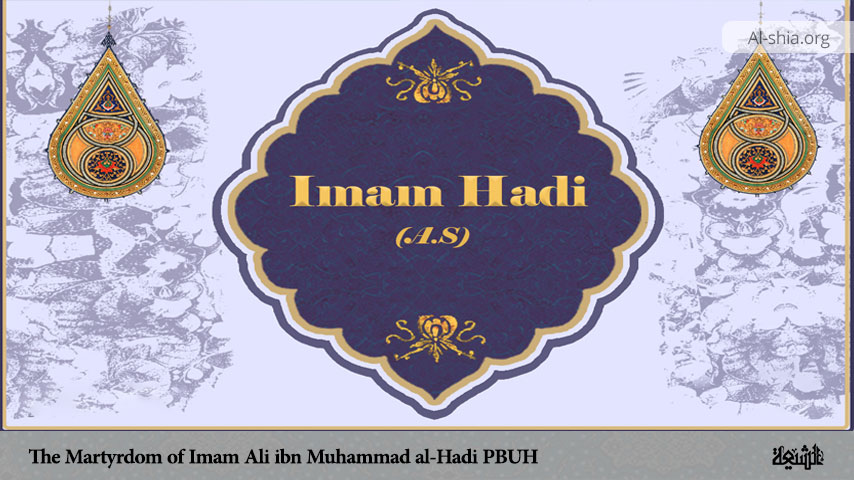Introduction
Imam Ali ibn Muhammad al-Hadi (a.s) is a member of the purified Household of the Prophet; those whom Allah has cleansed from every impurity and thoroughly purified[1], and their love and obedience have been made compulsory for every Muslim[2]. He is the tenth Imam from the household of the Prophet and the period of his leadership was between 220/835 and 254/868 for a period of thirty-four years. He lived during a tumultuous era marked by the oppressive rule of the Abbasid caliphs. Known for his profound wisdom, unshakable piety, and steadfast leadership, he guided his followers amidst relentless political persecution. Despite enduring imprisonment and constant surveillance, the Imam’s influence in preserving Islamic teachings and strengthening his community remained unyielding. His martyrdom, a result of Abbasid tyranny, marks a solemn chapter in Islamic history, symbolizing the sacrifices of the Ahl al-Bayt (a.s) in upholding justice, truth, and divine guidance for humanity.
His Lineage
Imam Ali al-Hadi was from the noblest and most exalted lineage in the world. His father was Imam Muhammad al-Jawad, the son of Imam Ali al-Rida, the son of Imam Musa al-Kadhim, the son of Imam Ja’far Sadiq, the son of Imam Muhammad al-Baqir, the son of Imam Ali Zayn al-Abideen, the son of Imam al-Husain, the son of Imam Ali ibn Abu Talib (peace be upon them). His mother was Samana[3] (or Susan), a freed slave of Maghribi origin[4]. She was a woman of high moral conduct and devoted herself to the worship of Allah. According to a report, she spent her nights worshipping and reciting the Book of Allah[5].
His Birth
According to a report, Imam Ali al-Hadi was born on 16 Dhul al-Hijjah 212/7 March 828 in Surayya, a village three miles from Medina founded by his great-grandfather, Musa al-Kadhim. Sheikh Mufid writes in this regard: “He was born at Ṣurya in Medina, the city of the Apostle, in the middle of the month of Dhū al-Ḥijja in the year 212 A.H. (828)[6]“. Another mentioned date was the 2nd day of Rajab, 212[7] (1st of October, 827).
His Title and Teknonym
Imam Ali ibn Muhammad has several titles including al-Hadi (the guide); al-Naqi (the pure); An-Nasih (loyal); Al-Mutawakkil (reliant on Allah); At-Taqiy (pious, devout); Al-Murtadha (being pleased with Allah); Al-Faqeeh (jurisprudent); Al-Aalim (knowledgeable); Al-Ameen (trustee on religion and life); At-Tayyib (generous, kind-hearted, good-natured); Ar-Rasheed (wise, prudent); Ash-Shaheed (the martyr); Al-Wafiy (loyal) and Al-Khalis (pure from every defect and bad)[8].
His teknonym was Abu al-Hasan. However, in hadith sources, Imam Ali al-Hadi is known as Abu al-Hasan al-Thalith (the third Abu l-Hasan) while Imam al-Kadhim (a.s) is called Abu al-Hasan al-Awwal (the first Abu l-Hasan) and Imam al-Rida (a.s) is called Abu l-Hasan al-Thani (the second Abu l-Hasan).
His Personality and Character
Imam Hadi (a.s) just like his father and honorable grandfathers, was a perfect human, possessing all high human virtues. He resembled his grandfather Imam Ali (a.s) in eloquence and rhetoric, and his grandfather Imam Zayn al-Abidin in piety, worship, and asceticism. Historians mentioned wonderful anecdotes of the high conduct of Imam Hadi (a.s).
Imam Hadi (a.s) possesses an unequal mastery of religious sciences and exemplary moral excellence. While describing him (a.s), Ibn Hajar has said, “Abul Hasan (a.s.) was the holder of his father’s legacy regarding knowledge and generosity[9].”
Because of this, he (a.s) attempted to teach religious sciences to the Muslims, but unfortunately, he faced limitations that hindered his ideal performance. He (a.s) was formally under severe guarding of secret agents, therefore, the Shiites and advocates of Imam (a.s) faced limitations for gaining knowledge from him. That is why the traditions narrated from him are scarce. However, there are some traditions from Imam Hadi (a.s) about religious principles, ethics, preaching, and various jurisprudential issues in Hadith books.
Besides, Imam Hadi (a.s) trained many students, whose names are recorded in history, tradition, and rijal books. The author of Manaqib has named scholar companions of Imam Hadi (a.s) this way: Dawud Ibn Ziyad Abu Salim Zankan, Husayn Ibn Muhammad Mada’ini, Ahmad Ibn ‘Isma’il Ibn Yaqtin, Bashar Ibn Bashar Niyshaburi Shadhani, Sulayman Ibn Ja’far Marwazi, Fat’h Ibn Yazid Jurjani, Muhammad Ibn Sa’id Ibn Kulthum, Mu’awiyah Ibn Hakim Kufi, Ali Ibn Muhammad Ibn Muhammad Baghdadi, Abul Hasan Ibn Raja’ Abarta’i[10].
Ibn Shahr ‘Ashub has described Imam Ali Al-Naqi (a.s) thus: “He was the most perfect and the nicest of all the people. When he was silent, his dignity increased and when he talked his illumination appeared. He was from the family of Prophethood, Imamate, and caliphate of the Muslims. He was a branch from the great Prophethood tree, but benefitting from him did not last long. He was the fruit of prophecy tree, which was selected a short time after getting ripe[11].”
Ibn Sabbagh Maliki has narrated from some scholars, thus: “The virtues of Abul- Hasan Ali Ibn Muhammad Hadi (a.s.) are like a tent that stands on the land of honor and whose ropes are attached to the stars. Any virtue or excellence that is mentioned he possesses. He is worth any praise. Any gratitude or respect deserves him. His merits, virtues, and honor are rooted in his essence, keeping him away from vices, just as a cameleer maintains the little camels from dangers. His soul is pure, his ethics are good, and his conduct is excellent[12].”
His Leadership
After the martyrdom of his father, the ninth Imam (a.s) in 835 AH, Ali al-Hadi gained the official role of Imamate while still he was a minor. Consequently, the companions and followers of his father agreed on his Imamate, except for a small group who gathered around his younger brother, Musa, who when dissociated himself from them, turned to al-Hadi. According to his father’s will, he was to receive his estates, property, and slaves after reaching the majority to the exclusion of his brother Musa.
In the beginning, Imam Ali Hadi (a.s) lived twenty-two years in Medina. According to history, the rulers in Baghdad watched Imam Hadi (a.s) by their agents in Medina. Al-Mutawakkil was the most spiteful towards Imam al-Hadi (a.s) from among all the Abbasid caliphs and he oppressed him too much.
Al-Mutawakkil was not satisfied with watching the Imam from a distance, so he decided to take Imam (a.s) from Medina to Samarra, in 233/847-8. When the Imam (a.s) reached Baghdad, many people gathered to see him. Thereafter, he moved to Samarra where he lived for the rest of his life.
The Imam (a.s) remained in Samarra for the rest of his life under constant observation. However, he (a.s) was able to maintain secret communications with the Shia living in various areas through an intricate network of representatives. He (a.s) would receive the religious dues from the believers, as well as answer questions on faith, Islamic law, and politics[13]. Imam Ali al-Hadi (a.s) resided in Samarra for ten years and some months until his death.
Meanwhile, here are some reports of his nomination for the imamate and of his being indicated for succession:
Abū al-Qāsim Ja‘far ibn Muḥammad informed me on the authority of Muḥammad ibn Ya‘qūb, on the authority of ‘Alī ibn Ibrāhīm, on the authority of his father, on the authority of Ismā‘īl b. Mihrān, who said: When Abū Ja‘far (al-Jawād) left Medina for Baghdād on the first of the two occasions in which he did so, I (i.e. Ismā‘īl b. Mihrān) said to him at his departure: “May I be your ransom, I am afraid for you with regard to this situation. To whom does the affair (of the Imamate) belong after you?” He turned his face towards me, laughing, and said to me: “It is not as you think this year”. When he was summoned to al-Mu‘taṣim, I went to him and said: “May I be your ransom, you are outside (our normal reach). To whom does this affair belong after you? He wept until his beard became damp. Then he turned to me and said: “On this occasion when there is fear for me, (it should be known that) the affair (of the Imamate) after me belongs to my son, Alī[14]“.
It is pertinent to mention that the period of the leadership of Imam Ali Hadi was for a period of thirty-four years, between 220/835 and 254/868[15].
His Martyrdom
Imam Ali al-Hadi remained under close surveillance and political pressure, but he continued to reject injustice with steadfast resistance and never submitted to corruption. According to some reports, Al-Mu’tazz al-‘Abbasi poisoned Imam al-Hadi (a.s) and martyred him[16]. Imam Abu Muhammad al-Hasan al-Askari (a.s) washed the pure body of his father, enshrouded it, and offered the prayer of the dead on it while his heart was full of pain, sorrow, and regret.
Sheikh al-Mufid and others reported that Imam al-Hadi (a.s) was martyred at Samarra in the month of Rajab in the year 254 A.H. (July, 868) when he was forty-one years and some months[17]. On the contrary, some historians reported that Imam (a.s) died on Monday, the twenty-fifth of Jumada al-Akhirah in 254 A.H when he was forty years old[18] and his shrine is in Samarra, Iraq.
Conclusion
The martyrdom of Imam Ali ibn Muhammad al-Hadi (a.s) stands as a profound testament to the resilience and unwavering commitment of the Ahlul Bayt (a.s) in preserving the essence of Islam. Despite facing severe oppression and hostility from the Abbasid rulers, the Imam continued to illuminate the path of truth and guidance for his followers. His sacrifice underscores the enduring struggle for justice and faith in the face of tyranny. For generations, his life and martyrdom have inspired believers to remain steadfast in their devotion to divine principles and the legacy of the Prophet’s household.
References
[1] . Qur’an 33: 33.
[2] . Qur’an 42: 23.
[3] . WOFIS, A brief history of the fourteen Infallibles, p. 161.
[4] . Momen, Moojan (1985). An Introduction to Shi’i Islam, p. 43.
[5] . Refer to Uyun al-Mu’jizat (quoted by Baqir Shareef al-Qurashi, The Life of Imam ‘Ali al-Hadi, Study and Analysis, pp. 9-10).
[6] . Sheikh Mufid, al-Irshād, p. 465.
[7] . WOFIS, A brief history of the fourteen Infallibles, p. 161.
[8] . Baqir Shareef al-Qurashi, The Life of Imam ‘Ali al-Hadi, Study and Analysis, pp. 9-10.
[9] . Ibn Hajar, Al-Sawa’iq Al-Muhriqah, Vol 1, p. 207.
[10] . Ibrahim Amini, Imamate and the Imams, p. 152.
[11] . Ibn Shahr ‘Ashub, Manaqib ‘Ali Abi Talib, Vol 4, p. 432.
[12] . Ibn Sabbagh, Al-Fusulul Muhimmah, p. 264.
[13] . Ja’far Subhani, Seeratul A’immah, pp. 510-511.
[14] . Kulayni ibn Ya’qub, Al-Kāfī, I, 232, Hadith No. 1.
[15] . Mufid, Muhammad, al-Irshād, p
[16] . Muhammad ibn Jarir al-Tabari, Dala’il al-imama, p. 409
[17] . Mufid, Muhammad, al-Irshād, p. 465.
[18] . Nur al-Absar, p.150; Kashf al-Ghummah, vol.3 p.174


















